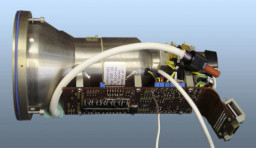The F-16C (single seat) and F-16D (two seat) variants entered production in 1984. The first C/D version was the Block 25 with improved cockpit avionics and radar which added all-weather capability with Beyond Visual Range (BVR) AIM-7 and AIM-120 air-air missiles. Blocks 30/32, 40/42 and 50/52 were later C/D versions. The LANTIRN Diffractive optics HUD was designed for the new aircraft but development was delayed by the complexity of the manufacturing problems. As an interim the Company offered a wide angle conventional optic design.
The initial order was placed in 1984 and was valued at nearly $50 million (then about £30 million) to cover both development and production. Over 2300 HUD’s were delivered for the F-16 and the system has been the basis of equipment supplied for other programmes such as for the A-7D/K and F-5 adding another 1500 units to the family. In 1985 the F-16C/D design won the Queen’s Award for Technology Improvements to aircraft Head Up Display systems for the Company.
The HUD Pilot's Display Unit (PDU)
The HUD PDU has both a raster and a cursive capability with the first application of ‘cursive in flyback’ in which the same amount of symbology as in the daytime high brightness mode can be drawn on the CRT using the raster flyback period of the Night mode. A good grey scale was provided for sensor video and the system could operate in 525, 625, or 875-line standards. The system accuracy was enhanced by the ability to apply corrections for the windshield. The F-16 windshield in particular acts as a lens which modifies the focus of the system and this is compensated for in the optical module design but in addition there are linear distortions away from the centre of the field of view caused by the curvature of the one-piece canopy and manufacturing variations. It is possible to provide both a generic and a specific correction for the particular aircraft. The optics provides a 25 degree Total Field of View and a 20 degree by 13.5 degree Instantaneous Field of View which was the maximum that could be achieved within the limitations of the 6.7-inch exit lens design and the large distance between the pilot and the HUD occasioned by the reclined high ‘G’ seat. The exit lens is truncated, and the size is limited by the ability of the glass to withstand thermal shock. The field of view is about the maximum that can be achieved with a conventional refractive optics.
The Cathode Ray Tube is circular but with a blank area at the bottom; the beam is deflected into this area so that raster and cursive display luminance calibration tests can be carried out without illuminating the phosphor. As usual the deflection is magnetic and the focus electro-static. The deflection coils and the matching card are now all constructed by Rank Electronic Tubes and the item is delivered as a Tube Unit Assembly. The venerable P1 phosphor is still used but the final Anode voltage is now a nominal 18kV and the tube operates with a Focus voltage of 2.96kV to 4.76kV.
The Camera was left forward of the Combiner to retain commonality with the LANTIRN design. In a refractive optic design, the outside world and symbology can be captured from aft of the Combiner but with the reflective design this is not possible, and the symbology is added to the outside world view by video mixing after scan conversion in the Electronics Unit.
The Head Up Display castings were all made by Kent Alloys who worked for Medway Investment Castings.
The HUD Electronics Unit (EU)
The F-16 C/D Electronics Unit contains twenty circuit boards. The Processor/Symbol Generator uses the MIL-STD 1553B (Standardised Electronic Data Highway) databus architecture, the MIL-STD-1750 (Standardised Computer architecture) processor and the MIL-STD-1589A (Standardised Jovial J73 Computer language) software. This was the first time that all three Standards had been used together and the Company was way ahead of its US rivals in this respect. The foundations for the implementation of these Standards was laid down by FARL from 1978 and led to a highly successful LSI chipset for the 1553 Databus. The HUD EU has comprehensive video mixing and scan conversion and self-contained weapon aiming capability.





